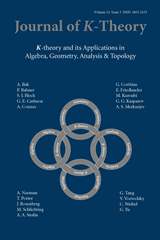Article contents
Sur l'homologie des groupes unitaires à coefficients polynomiaux
Published online by Cambridge University Press: 04 April 2012
Abstract
Let A be a ring with anti-involution and F a nice functor (tensor or symmetric power, for example) from finitely-generated projective A-modules to abelian groups. We show that the homology of the hyperbolic unitary groups Un,n(A) with coefficients in F(A2n) can be expressed stably (i.e. after taking the colimit over n) by the homology of these groups with untwisted coefficients and functor homology groups that we can compute in suitable cases (for example, when A is a field of characteristic 0 or a ring without ℤ-torsion and F a tensor power). This extends the result where A is a finite field, which was dealt with previously by C. Vespa and the author (Ann. Sci. ENS, 2010).
The proof begins by relating, without any assumption on F, our homology groups to the homology of a category of hermitian spaces with coefficients twisted by F. Then, when F is polynomial, we establish — following a method due to Scorichenko — an isomorphism between this homology and the homology of another category of (possibly degenerate) hermitian spaces, which is computable (in good cases) by standard methods of homological algebra in functor categories (using adjunctions, Künneth formula…). We give some examples.
Finally, we deal with the analogous problem for non-hyperbolic unitary groups in some special cases, for example euclidean orthogonal groups On (A) (the ring A being here commutative). The isomorphism between functor homology and group homology with twisted coefficients does not hold in full generality; nevertheless we succeed to get it when A is a field or, for example, a subring of ℚ containing ℤ[1/2]. The method, which is similar to that in the previous case, uses a general result of symmetrisation in functor homology proved at the beginning of the article.
Résumé
Soient A un anneau muni d'une anti-involution et F un foncteur raisonnable (puissance tensorielle, symétrique, par exemple) défini sur les A-modules projectifs de type fini, à valeurs dans les groupes abéliens. On montre que l'homologie du groupe unitaire hyperbolique Un,(A) à coefficients dans F(A2n) s'exprime stablement (c'est-à-dire lorsqu'on prend la colimite sur n) à partir de l'homologie de ce groupe à coefficients constants et de groupes d'homologie des foncteurs accessibles au calcul dans les cas favorables (par exemple, lorsque A est un corps de caractéristique nulle, ou que A est un anneau sans torsion sur les entiers et F une puissance tensorielle). Cela généralise le résultat, antérieurement traité par C. Vespa et l'auteur (Ann. Sci. ENS, 2010), où A est un corps fini.
La démonstration consiste à d'abord relier, sans hypothèse sur F, les groupes d'homologie en question à l'homologie d'une première catégorie d'espaces hermitiens à coefficients tordus par F. Ensuite, dans le cas où F est polynomial, on établit l'isomorphisme, suivant une méthode élaborée par Scorichenko, entre cette homologie et celle d'une autre catégorie d'espaces hermitiens (éventuellement dégénérés), qui elle s'avère calculable (dans les cas raisonnables) par des techniques d'algèbre homologique classiques dans les catégories de foncteurs (utilisation d'adjonctions, de formules de Künneth…). On en donne quelques exemples.
Enfin, on aborde, dans certains cas particuliers, l'analogue de ce problème pour des groupes unitaires non hyperboliques, par exemple les groupes orthogonaux enclidiens On(A) (l'anneau A est ici commutatif). L'isomorphisme entre homologie des foncteurs et homologie des groupes à coefficients tordus ne vaut plus en toute généralité; toutefois, on parvient à l'établir lorsque A est un corps ou, par exemple, un sous-anneau de ℚ contenant ℤ [1/2]. Les méthodes, similaires aux précédentes, utilisent également un résultat général de symétrisation en homologie des foncteurs prouvé en début d'article.
Keywords
- Type
- Research Article
- Information
- Copyright
- Copyright © ISOPP 2012
References
Références
- 13
- Cited by




